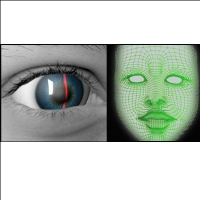L.A. County Quietly Rolling Out Mega Database for Collecting Personal Data
 (graphic: CBC News)
(graphic: CBC News)
Weaponry and gear aren’t the only military technology embraced by public law enforcement agencies across the country.
The Federal Bureau of Investigation (FBI) went operational with its Next Generation Identification System (NGI) earlier in the month, clearing the way for state and local authorities to hook up their growing databases of biometric information about residents—iris scans, photos for facial recognition, voice recordings, DNA profiles, fingerprints, etc—with the FBI, creating an awesome repository of data that will include people who have not been convicted of anything.
Last week, The Center for Investigative Reporting (CIR) published documents that indicated law enforcement agencies in Los Angeles County were poised to join the party. The Los Angeles County Information Systems Advisory Board―a multi-agency, multi-jurisdictional committee―is coordinating construction of a local Multimodal Biometric Identification System (MBIS) that conforms with FBI standards and will allow inclusion of its data on 15 million or so unsuspecting residents in the national database.
Searching for links to news stories about the board or MBIS on Google turns up just about nothing. The collection, warehousing and sharing of the most personal of information about people in government and private sectors is rapidly escalating with very little public discussion, much less approval.
“There are privacy and civil liberties implications that come from law enforcement having multiple ways to identify someone without their consent,” Jeramie Scott, national security counsel for the Electronic Privacy Information Center (EPIC), told CIR.
The potential negative repercussions are limitless. The temptation to make a buck off this information, especially for cash-strapped governments, will be a powerful incentive to do bad things. Opportunities for identity theft will multiply.
Eventually, the FBI database could be cross-referenced with medical, financial, household and legal records; stuff already aggregated by data brokers; police license-plate scanner data; DMV’s 32-million photo database; and information scooped up from phones and computers by the National Security Agency (NSA).
The Department of Homeland Security has spent hundreds of millions of dollars funding local and state surveillance systems that are said to include 30 million cameras. They capture crowd shots and innocent people in public settings.
San Diego participated in a program that equipped officers with a computer tablet or mobile phone to snap a picture of someone they encounter and query the database in one seamless procedure. According to a Tactical Identification System (TACIDS) draft policy reviewed by the Electronic Frontier Foundation (EFF), officers could take a picture if they had consent or had lawfully detained a subject. But a third option is more problematic. Images could be collected from social media, security cameras and “from a distance as part of surveillance operations.”
Next Generation will eventually replace the FBI’s Integrated Automated Fingerprint Identification System, which is fed by 18,000 law enforcement agencies. Last December, EPIC predicted the seven stages of the rollout would be completed by the end of 2014.
The FBI is early.
–Ken Broder
To Learn More:
LA County to Collect More Personal Data without Public Notice (by Ali Winston, The Center for Investigative Reporting)
San Diego County Quietly Scanning Faces for Its Growing Surveillance Database (by Ken Broder, AllGov California)
FBI’s Facial Recognition Program Goes Operational (by Noel Brinkerhoff and Steve Straehley, AllGov)
The FBI’s Next Generation Identification Program: Big Brother’s ID System? (Electronic Privacy Information Center)
- Top Stories
- Controversies
- Where is the Money Going?
- California and the Nation
- Appointments and Resignations
- Unusual News
- Latest News
- California Forbids U.S. Immigration Agents from Pretending to be Police
- California Lawmakers Urged to Strip “Self-Dealing” Tax Board of Its Duties
- Big Oil’s Grip on California
- Santa Cruz Police See Homeland Security Betrayal in Use of Gang Roundup as Cover for Immigration Raid
- Oil Companies Face Deadline to Stop Polluting California Groundwater





